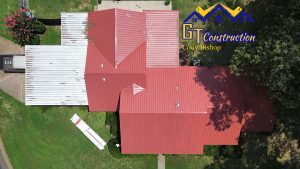Do metal roofs attract heat and increase energy costs?
Absolutely not. Compared to most other roofing materials, metal roofing is one of the most energy-efficient and coolest roofs on the market today. Large surface areas with thinner yet stronger material dissipated heat back into the atmosphere at a far superior rate.
The above is from our FAQs Page but we are going to expound on this below:
Since the roof is exposed to the sun more than any other part of the home, it plays a crucial role in regulating temperature and the home’s overall energy efficiency.
As energy costs continue to rise, metal roofs have emerged as the top choice amongst homeowners in search of energy-efficient solutions for their homes–and for good reason.
Metal roofs are one of the most energy-efficient roofing materials on the market because they reflect heat up and away from buildings. In fact, a metal roof can save homeowners up to 40% in energy costs.
What Makes Metal Roofing so Energy Efficient?
An energy-efficient roof must perform well in all three of these categories:
Reflectivity: The ability of the roof to reflect heat back to the direction from which it came.
*Thermal Emittance and Emissivity: While thermal emittance and emissivity both measure how well the roof’s surface can cool down, they aren’t the same. Thermal emittance is specifically related to the roof’s ability to cool itself by emitting thermal radiation, whereas emissivity is a measure of how well the roof can release absorbed heat back into the environment.
*The term emissivity is generally used to describe a simple, homogeneous surface such as silver. Similar terms, emittance and thermal emittance, are used to describe thermal radiation measurements on complex surfaces such as insulation products. (wikipedia)
Ventilation: A well-ventilated roof allows hot air to escape while promoting the flow of cooler air.
Metal roofing checks all three of these boxes with ease.
Here’s why:
Reflectivity
A reflective roof minimizes heat absorption while maximizing the reflection of sunlight.
Cheap or low-quality roofing materials, such as traditional asphalt shingles, have extremely poor reflectivity and absorb heat like a sponge.
Metal roofs, on the other hand, are highly reflective and can reflect up to 70% of the sun's energy back into the atmosphere. And since a metal roof reflects heat up and away from the home, less heat is absorbed by the roof, and the home stays cooler.
Thermal Emittance and Emissivity
Thermal emittance measures how efficiently a roof can release the heat it has absorbed. The higher the emittance, the better the material can release heat.
Metal has an extremely high rating for thermal emittance due to its unique atomic structure. Metals are made of atoms that are arranged in a lattice structure with free-flowing electrons that can easily move and transfer energy within the material. The free-flowing electrons are responsible for the high conductivity of metal and its ability to effectively transfer and emit thermal energy.
When the metal roof is heated by the sun, the heat energy quickly spreads across the surface and emits the heat back into the atmosphere.
Ventilation
A properly ventilated roof system allows hot air to escape while promoting the flow of cooler air. Installing a roof on battens creates an air gap between the roof and the metal panels, allowing for ventilation and air circulation. This ventilation above the roof’s sheathing prevents heat from building up in attics or ceiling areas.
Asphalt shingles and wood shakes are installed directly on the underlying plywood. With no airspace below the roofing materials, heat from the sun is trapped below the roof, increasing HVAC costs and reducing the overall energy efficiency of the home.
Since metal roofs are often attached to the roof using a batten system, the air is able to easily flow under the roof.
For intricate roof designs that would be complicated by the raised batten grid. However, metal roofing products –direct-to-deck products–are engineered to include a critical ¾” airspace.
This allows for energy-saving airflow that supports a consistent temperature throughout the entire roof.

Project Manager Cody Bishop

Project Manager Don Wood
